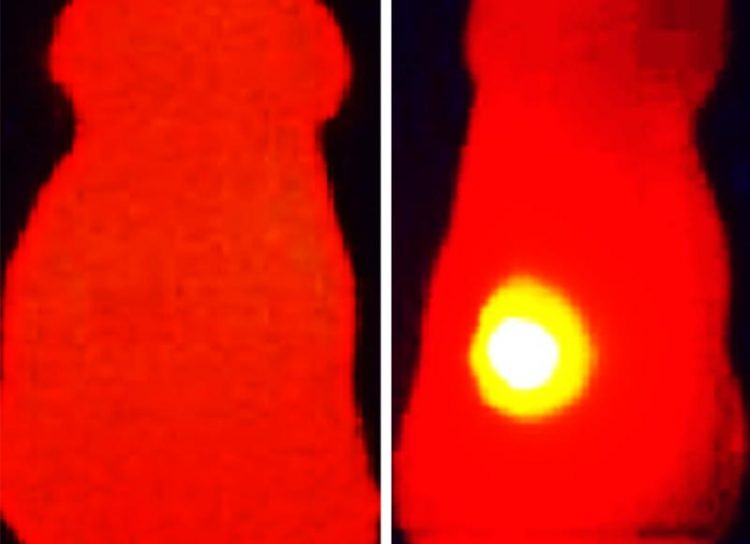Black nanoparticles slow the growth of tumors

Infrared thermal images - Right side: Elevated tumor (yellow) temperature in mice after laser irradiation in with OMV-melanin treated mice. Left side: mouse treated with OMVs without melanin Vipul Gujrati / Technical University of Munich
Nanoparticles are considered a promising weapon in the fight against tumors due to the fact that tumor tissue absorbs them more readily than healthy cells because their vascular system is more permeable. A good example is provided by outer membrane vesicles (OMVs), which are basically small bubbles surrounded by bacterial membrane.
These 20- to 200-nanometer particles are of interest because they are biocompatible, biodegradable and can be easily and inexpensively produced in bacteria, even in large volumes. Once loaded with medicinal active agents, they are easy to administer.
Nanoparticles carrying a black cargo
The huge potential of OMVs in tumor diagnosis and treatment has been demonstrated by Prof. Vasilis Ntziachristos, Professor of Biological Imaging at TUM, and his team. Their work builds on the characteristic properties of OMVs and melanin.
Dr. Vipul Gujrati, first author of the study, explains the principle: “Melanin absorbs light very readily – even in the infrared spectrum. We use precisely this light in our optoacoustic imaging technique for tumor diagnosis. It simultaneously converts this absorbed energy into heat, which is then emitted. Heat is also a way to combat tumors – other researchers are currently exploring this method in clinical trials.”
Optoacoustics, a method which has been significantly advanced by Ntziachristos, combines the benefits of optical imaging and ultrasound technology. Weak laser pulses gently heat the tissue, causing it to briefly expand very slightly. Ultrasound signals are produced when the tissue contracts again as it cools down. The measured signals vary depending on the tissue type. The scientists record them with special detectors and “translate” them into three-dimensional images. Sensor molecules or probes (such as OMVs) can improve the specificity and accuracy of the technique even further.
Heat build-up reduces tumor growth
The scientists initially had to overcome a problem specific to melanin: It is not very water-soluble and therefore difficult to administer. This is where the OMVs came into play. The researchers engineered bacteria in such a way that they produce melanin and store it in their membrane derived nanoparticles. They then tested the black nanoparticles in mice which had tumors in their lower back region. The particles were injected directly into the tumor, which was excited with infrared laser pulses as part of the optoacoustic procedure.
OMVs proved to be suitable sensor probes for this diagnosis technique because they delivered sharp, high-contrast images of the tumor. They are also well-suited to photothermal therapy approaches, where the tumor tissue is heated with stronger laser pulses in order to kill the cancer cells. The melanin in the nanoparticles caused the temperature of the tumor tissue to rise from 37 °C to up to 56 °C. Control tumors with no melanin only reached a maximum temperature of 39 °C. In the ten days following the treatment, the tumors grew at a significantly slower rate than those in the control group that had not received melanin OMVs. This heat effect was amplified by another positive effect of the particles: By causing a slight non-specific inflammation in the tumor tissue, the immune system was triggered to attack the tumor.
“Our melanin nanoparticles fit into the new medical field of theranostics – where therapy and diagnostics are combined. This makes them a highly interesting option for use in clinical practice,” says Ntziachristos. The scientists will now develop their OMVs further to bring them into clinical use in the future.
More information:
Prof. Vasilis Ntziachristos holds a chair at TUM. He is research group leader at the Central Institute for Translational Cancer Research at TUM (TranslaTUM) and Director of the Institute of Biological and Medical Imaging at Helmholtz Zentrum München.
Dr. Vipul Gujrati
Scientist at the Chair of Biological Imaging
Technical University of Munich
Tel.: +49 (0)89 3187 1244
vipul.gujrati@tum.de
Vipul Gujrati, Jaya Prakash, Jaber Malekzadeh-Najafabadi, Andre Stiel, Uwe Klemm, Gabriele Mettenleiter, Michaela Aichler, Axel Walch and Vasilis Ntziachristos: Bioengineered bacterial vesicles as biological nanoheaters for optoacoustic imaging, Nature Communications, March 7, 2019, DOI: 10.1038/s41467-019-09034-y
https://www.nature.com/articles/s41467-019-09034-y
https://www.tum.de/nc/en/about-tum/news/press-releases/detail/article/35324/ – This text on the web
https://www.cbi.ei.tum.de/en/labs/ – Research group headed by Vasilis Ntziachristos
http://www.professoren.tum.de/en/ntziachristos-vasilis/ – Profile of Vasilis Ntziachristos
Media Contact
All latest news from the category: Health and Medicine
This subject area encompasses research and studies in the field of human medicine.
Among the wide-ranging list of topics covered here are anesthesiology, anatomy, surgery, human genetics, hygiene and environmental medicine, internal medicine, neurology, pharmacology, physiology, urology and dental medicine.
Newest articles

Bringing bio-inspired robots to life
Nebraska researcher Eric Markvicka gets NSF CAREER Award to pursue manufacture of novel materials for soft robotics and stretchable electronics. Engineers are increasingly eager to develop robots that mimic the…

Bella moths use poison to attract mates
Scientists are closer to finding out how. Pyrrolizidine alkaloids are as bitter and toxic as they are hard to pronounce. They’re produced by several different types of plants and are…

AI tool creates ‘synthetic’ images of cells
…for enhanced microscopy analysis. Observing individual cells through microscopes can reveal a range of important cell biological phenomena that frequently play a role in human diseases, but the process of…





















